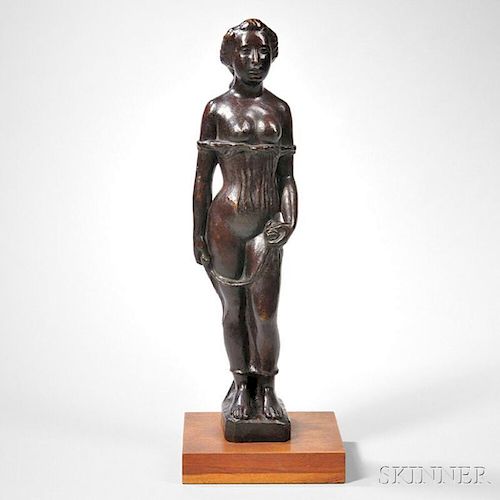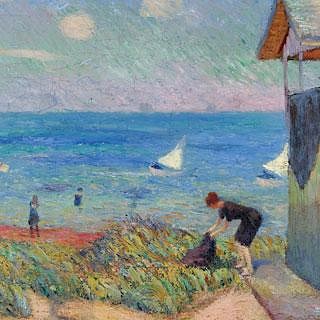Aristide Maillol (French, 1861-1944) Petite Flore drapée
Lot 368
About Seller
Bonhams Skinner
274 Cedar Hill Street
Marlborough, MA 01752
United States
Founded over four decades ago, Bonhams Skinner offers more than 60 auctions annually. Bonhams Skinner auctions reach an international audience and showcase the unique, rare, and beautiful in dozens of categories, including the fine and decorative arts, jewelry, modern design, musical instruments, sc...Read more
Categories
Estimate:
$120,000 - $180,000
Absentee vs Live bid
Two ways to bid:
- Leave a max absentee bid and the platform will bid on your behalf up to your maximum bid during the live auction.
- Bid live during the auction and your bids will be submitted real-time to the auctioneer.
Bid Increments
| Price | Bid Increment |
|---|---|
| $0 | $10 |
| $100 | $25 |
| $500 | $50 |
| $1,000 | $100 |
| $3,000 | $250 |
| $5,000 | $500 |
| $10,000 | $1,000 |
| $30,000 | $2,500 |
| $50,000 | $5,000 |
| $100,000 | $10,000 |
| $300,000 | $25,000 |
| $500,000 | $50,000 |
| $1,000,000 | $100,000 |
About Auction
By Bonhams Skinner
May 29, 2015 - May 30, 2015
Set Reminder
2015-05-29 16:00:00
2015-05-30 16:00:00
America/New_York
Bidsquare
Bidsquare : American & European Paintings
https://www.bidsquare.com/auctions/skinner/american-european-paintings-649
Bonhams Skinner bidsquare@bonhamsskinner.com
Bonhams Skinner bidsquare@bonhamsskinner.com
- Lot Description
Aristide Maillol (French, 1861-1944)
Petite Flore drapée, édition Ambroise Vollard
Signed "Aristide Maillol" in the bronze on the left side of the base.
Bronze with dark brown patina, height 26 3/8 in. (67.0 cm), on a wooden plinth.
Condition: Small surface loss between the feet, areas of minor wear to the patina, dust and dirt to the interstices.
Provenance: Purchased from Charles E. Slatkin Galleries, New York, in 1959.
N.B. Aristide Maillol began his artistic career as a painter. Trained at the Ecole des Beaux Arts under Jean Léon Gerome and Alexandre Cabanal, his early paintings were influenced by the Nabis and Symbolists, particularly Maurice Denis and Paul Gauguin. With Gauguin's encouragement, Maillol took up tapestry design, and in 1893 he opened a tapestry workshop in his birthplace, Banyuls, winning accolades for technique and artistry. However, reportedly faced with the threat of possible blindness, Maillol began to experiment with sculpture, first with small terra cotta works in 1895, and by 1899 he had abandoned tapestry in favor of sculpture. In 1902 Maillol created his first major sculpture A Seated Woman, modeled after his wife Clothilde. It was in that same year that dealer Ambroise Vollard gave Maillol his first exhibition. The artist was already 40 years old.
Maillol's sculpture focused on the human body, primarily the mature female form, rooted in classical sculpture, with emphasis on synthesized shapes, monumentality, solidity, and stillness. He likened sculpture to architecture, balancing the masses found in the natural human body, its individual parts like building blocks, simplified and emphasized. (1)
Maillol wrote, "The particular does not interest me; what matters is the general idea." (2) He rejected the spiraling forms, dynamic space, and agitated surfaces of works by Rodin, for example, in favor of smooth, rounded forms conceived almost as separate volumes which come together in harmonious arrangement. This new approach would be pushed further by the next generation of modern sculptors, including Constantine Brancusi, Jean Arp, and Henry Moore.
The sculpture at hand is a bronze published by Ambroise Vollard during Maillol's lifetime. Vollard created two different editions of Petite Flore Drapée. One was a numbered edition of six. These casts included foundry marks from Alexis Rudier, Florentin Godard, or Valsuani. The other edition, to which this sculpture belongs, did not include foundry marks, and the identity of the foundry or foundries is not known. Ambroise Vollard did not number the casts, and the edition size remains unknown. It is interesting to note that an early version of Petite Flore Drapée was carved c. 1901 in wood and is reproduced in John Rewald's book, Maillol (London: The Hyperion Press, 1939), p. 126.
We would like to thank Olivier Lorquin for his kind assistance cataloging this lot.
1. Herbert Christian Merillat, Modern Sculpture: The New Old Masters (New York: Dodd, Mead & Company, 1974), p. 12.
2. Andre Carnduff Ritchie, Sculpture of the Twentieth Century (New York: Museum of Modern Art), p. 39.
Estimate $120,000-180,000
The absence of a condition statement does not imply that the lot is in perfect condition or completely free from wear and tear, imperfections or the effects of aging. Condition requests can be obtained via email (lot inquiry button) or by telephone to the appropriate gallery location (Boston/617.350.5400 or Marlborough/508.970.3000). Any condition statement given, as a courtesy to a client, is only an opinion and should not be treated as a statement of fact. Skinner Inc. shall have no responsibility for any error or omission. - Shipping Info
-
Please visit http://www.skinnerinc.com/services/payment-and-shipping/ for information regarding the collection of items purchased at auction.
-
- Buyer's Premium



 EUR
EUR CAD
CAD AUD
AUD GBP
GBP MXN
MXN HKD
HKD CNY
CNY MYR
MYR SEK
SEK SGD
SGD CHF
CHF THB
THB














